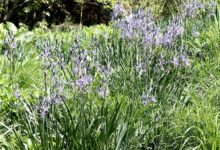
This underused spring bulb is a blue-blooming native: George’s Plant Pick of the Week
Here’s PennLive garden writer George Weigel’s Plant Pick of the Week for this week:
* Common name: Wild hyacinth, Indian hyacinth, camass
* Botanical name: Camassia leichtinnii, cusickii, quamash, scilloides
* What it is: Despite being a U.S. native species, the spring-flowering bulb family of Camassia is seldom planted in home gardens.
These produce foot-tall spikes of blue star-shaped flowers that open from the bottom up from May into early June. They’re trouble-free, they naturalize well (i.e. come back reliably from year to year), and they’re hardly ever bothered by rodents or deer.
Camassia also deal with moist soil better than most bulbs, meaning they’re good candidates for use in damper spots where daffodils and tulips would rot.
Blue to purplish-blue is the main bloom color, but pink and white varieties are available in catalogs. Camassia makes a good cut flower, too.
* Size: Most types grow two to two-and-a-half feet tall (including the flower spikes), except for Camassia scilloides (native to Pennsylvania), which tops out at a shorter one to two feet. Plant bulbs six inches apart.
* Where to use: As with most bulbs, camassia looks best when planted in a mass – especially since they naturalize well. But they can also be mixed into any bulb planting or even a perennial garden. Since camassia is one of the few bulbs that tolerate damp soil, they’re a candidate for a rain garden. Plants bloom best in full sun to light shade.
* Care: Plant bulbs in October. The strappy foliage will emerge in early to mid-spring, followed by the flower spikes in May and early June. Flower spikes can be cut off after they bloom, but keep the foliage in place at least until it yellows as it heads into dormancy the rest of the year.
Scatter the ground with Bulb-tone, Bulb Booster, or a balanced organic fertilizer each spring.
Bulbs can be dug and divided at leaf cutback time if you want to move any. They can also be dug, divided, and moved in fall if you can find the buried bulbs without slicing into them.
* Great partner: None needed if you’re planting a mass of them. In smaller amounts, they pair well with pastel-colored perennials that also bloom in the May/June time frame, such as salvia, catmint, hardy geraniums, and iris. Good May-blooming shrub partners are deutzia, lilac, weigela, and viburnum.



